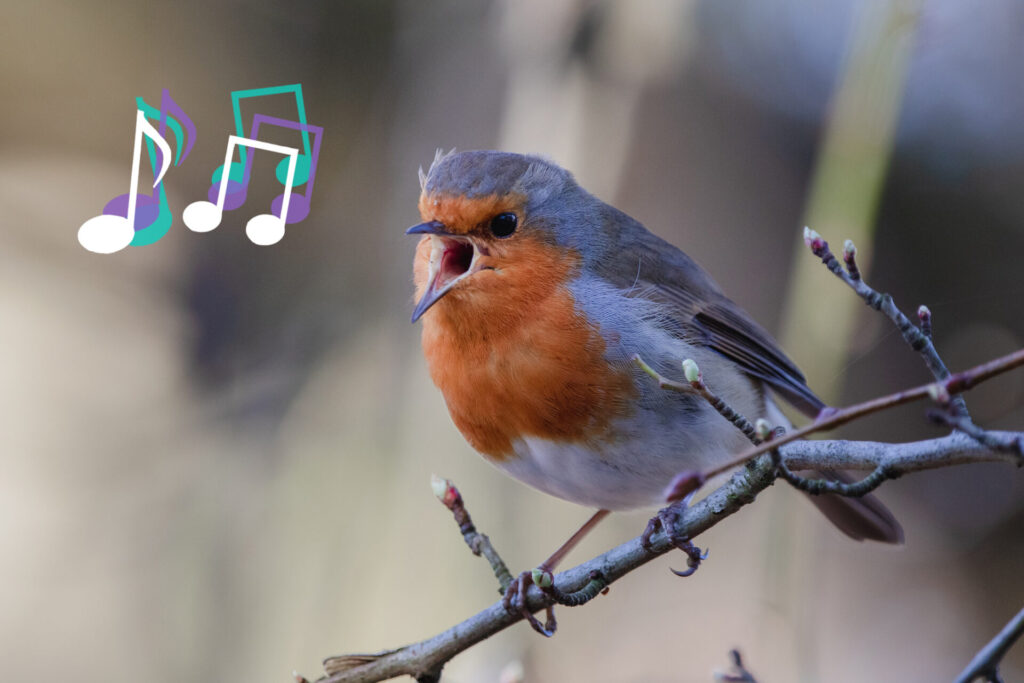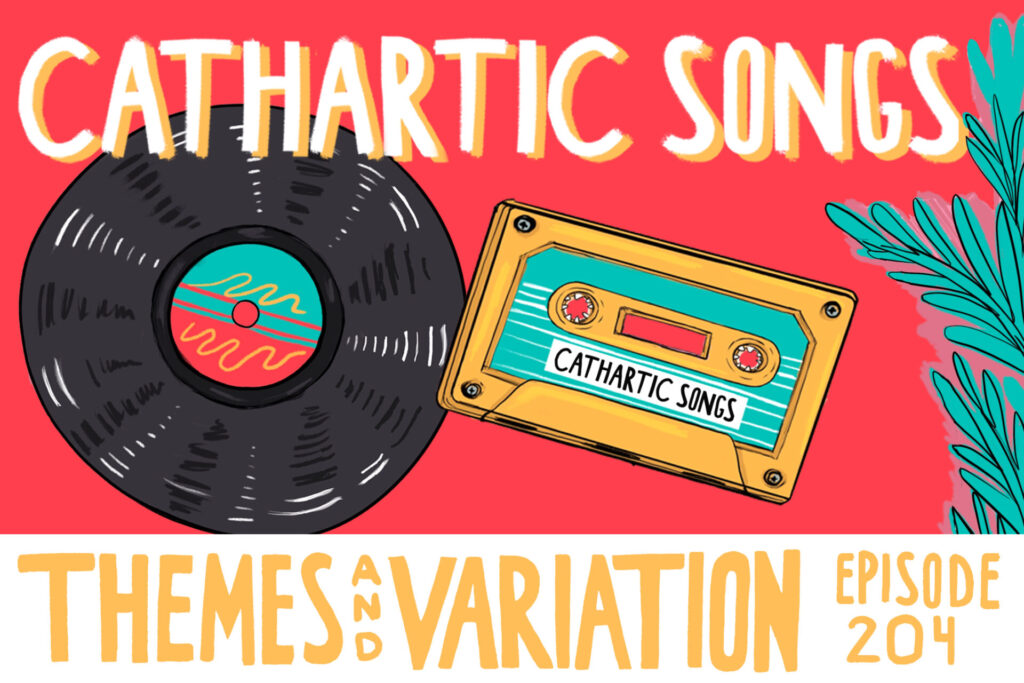+ Take your modern jazz piano and hip-hop beat making to new heights with Soundfly’s new course, Elijah Fox: Impressionist Piano & Production!
Pausing next to tall brush, maple and oak trees, and I hear the calls of a bird in the immediate environment around me. This little bird is singing a simple melody, two staccato eighth notes which repeat five times.
Its call is compelling; I am lost in the melody, picturing how it might be written as soprano notes on sheet music.
After two bars of the same melody, a second bird joins in, holding a single legato note. The first bird is a tufted titmouse and the second a blue jay. How and why would these two very different types of birds in stature, color, brain size, and behavior, with completely different calls be communicating with one another?
I listen as their interaction repeats, the blue jay singing with the titmouse in the exact same pattern of calls as in the first “verse.” The song continues for another two bars before a third bird joins in, a second blue jay joining the first, this jay singing two legato notes instead of one. The three musical voices sound cohesive, intentional.
Lost in reverie, I notice that this three-voice composition continues for four total bars before a fourth voice joins in, that of a house sparrow singing a percussive staccato to go along with the titmouse’s melody and the two blue jays’ harmony.
In this musical number are two separate octave ranges, a melody, harmony, and rhythm all blending cohesively. A human composer might have taken time and energy to cultivate something similar. To my human ear and brain this is music.
And in fact, the team here at Soundfly wanted to explore whether dogs actually understand music similarly to we do, so we did some research. Check out this video, courtesy of our YouTube channel.
At sunset in the same location, the Edith Read Wildlife Sanctuary in Rye NY, my wife and I walk from the wooded bird sanctuary to the beach, accidentally startling a group of sandpipers nesting. We are greeted by harsh squawking, reverberating along the beach as the sandpipers warn each other about our approach.
Here at the same spot during different times of day are two different examples of birds using sound; the first being an ordered call and response melody, the second shrill, dissonant squawking to warn of possible threats. But why do they utilize sound in such a way? Do they enjoy singing as much as I enjoy listening?
Why do birds communicate through song?
There is broad variation in what birds communicate through their songs and why. Birds use specific calls to designate between larger objects, living or not, and smaller ones coming towards them. I hear a crow caw a single note. As I move closer to the crow’s territory, I hear a second crow nearby while the first crow now caws two separate notes. This happens as I move closer to their territory and possibly a nest.
Music is an essential part of human identity; it encompasses the spectrum of our emotions, from joy to sorrow to confusion to personal empowerment. For us, music is not just entertainment; it is a multilingual tool for communication, with different dialects which cross over. Music is ever-evolving, developing, and changing based on personal taste and innovation. Our repertoire of instruments has evolved, string sections and synths being part of DAW sound libraries, providing tremendous accessibility to everyone from bedroom producers to Hollywood film score composers.
As technology evolves, new sounds fill the world around us. Bird songs are influenced as much by these sounds in their environments as their native breed. Birds living in a more urban area with loud noises such as trucks and cars will process and repeat these sounds in the development of their songs.
Check this out:
Birds are literally bombarded with sound. Their decibels of hearing extend far lower and far higher than humans are even able to hear.
Because of how much sound they need to process at any point in time, they must be able to differentiate between the harsh sounds of the city and the solitary call from a mate, letting them know another bird, animal, person, or object is approaching its nest.
+ Read more on Flypaper: “Meet Takeo Ischi: Germany’s Virtuosic Chicken Yodeler.”
How do birds vary the qualities of their calls to suit their environment?
Bird songs and calls vary in bandwidth. Bandwidth, or how wide or narrow a sound is, is specific to the type of bird and its environment. Producers must think about bandwidth all the time; if a signal is too wide it can overpower or muddy the sounds of other instruments, while if it is too shrill (such as excess guitar feedback) that signal can sound unpleasant to the ear.
On that first occasion at the Wildlife Sanctuary, I noticed this difference in bandwidth, the titmouse’s song being a narrower bandwidth while the two blue jays’ section sounded wider. Here is an example of a titmouse’s song:
Now, listen to the blue jay:
For birds to know that it is their mate singing to them, they intentionally vary the degree of bandwidth used to communicate. This is of critical importance, especially in environments where there is plenty of extraneous noise, such as a city, or environments where noise can become drowned out by objects taking up space.
In wooded areas, narrower bandwidth travels a further distance, while with birds like gulls or sandpipers who inhabit areas closer to water, songs and calls utilize a wider bandwidth, since sounds with wider bandwidth travel further across bodies of water.
The singing of different birds occurring simultaneously sounds balanced because clear distinction and impeccable attention to detail is necessary between mates in differentiating sound signals, in order that they might mark their territory and protect the nest, as well as one another.
+ Learn production, composition, songwriting, theory, arranging, mixing, and more; whenever you want and wherever you are. Subscribe for full access!

I have often thought, wouldn’t it be amazing to be able to sing a melody and a harmony at the same time? Well, for birds this is possible!
Certain birds have an evolved larynx known as a syrinx, which is like a double voice box which enables them to sing multiple sections of their song at once at a lightning-fast speed. Not only are birds able to hear frequencies which people cannot, they also sing songs so quickly that we are only able to discern a small fraction of what they are singing at once.
The influence of other birds affects the output of birdsong, in some types of birds more than others. The aptly named mockingbird is known for imitating the calls of other birds in its song. Because mockingbirds imitate so many different types of birds, they are constantly learning new songs throughout their lives, while other types of birds learn a smaller repertoire of songs early on and stick to those. Thomas Jefferson’s pet mockingbird was even able to sing his favorite songs back to him.
Here is a brief example of the endless variety in the mockingbird’s approach to song:
Mockingbirds will expend energy necessary for flight and survival in the development of their songs, to the point that they tire themselves out and make themselves vulnerable to predators. But this willingness for the male mockingbird to leave himself vulnerable displays his strength and fortitude, thereby making him more attractive to mates.
Think about how many memorable songs from Broadway and current pop are focused on romantic duets. Birds do this as well! Male and female birds will sing courtship duets which strengthen their pair bond.
The Albert’s Lyrebird of Australia will go off to practice its song on its own. The lyrebird will spend months or even years practicing the same song, honing, and editing it until it is a finished product. When it comes time to attract mates the bird is prepared to display its song as the best, outshining competition with other male lyrebirds.
The lyrebird even has an elaborate mating dance to accompany its song. These birds are truly performance artists. Here’s a lyrebird in action:
As the lyrebird shows us, movement is as essential as sound in the development of communication. For both birds and humans, movement developed alongside sound in how we learned to communicate with one another. Because birds don’t have tongues to articulate words, birdsong functions as linguistic for them.
Yet even without the advantage of having tongues, similar brain connections occur in birds as in humans in the development of song for communication, in a way which closely resembles speech.
Are bird calls artistic?
To me personally, I think bird song can be appreciated for the art form it is, motives aside!
The bird kingdom in its harmonies, melodies, and collaboration is not limited in its approach to genre. They borrow from their surroundings, using sound to adapt to their environment. As a producer, I am inspired by bird song, hearing the same bird utter its percussive sound on the right and on the left side of me as I walk.
On occasion I have heard two birds singing together at once, one voice being the melody and the other the harmony. On other occasions I have heard many birds singing at once in sections, structured the way an orchestra might be, with melodic voices taking turns, crescendos and decrescendos, harmony, melody, and percussion. Structural builds lead to a solitary voice soaring above the others, like a soloist with all the other voices or octave ranges contributing and harmonizing.
There’s an artistry to that.
+ Read more on Flypaper: “Bernie Krause on Preserving the Voices of the Wilderness Before They Disappear Forever.”
I have also heard percussive sounding bird calls without any focus on melody or harmony but with complex rhythmic structure. Some bird calls sound like flutes or recorders while others sound like modern synths. Some birds’ natural range is in higher octaves, while some are middle and some lower. As different birds communicate, these octave ranges blend without one overshadowing the other.
Towards the end of the second part of his Sixth Symphony, Ludwig Van Beethoven composed a cadenza in which he used the flute to imitate the nightingale, the oboe to imitate the quail, and two clarinets to imitate the cuckoo. These different tonal instruments blend with one another as the instruments communicate the way these birds might, in their quest for territory.
Beethoven’s homage points to structural crossover in how humans and birds compose music.
While communication between different types of birds is fascinating, it is mind boggling that birds also use song to communicate with humans!
With his collection of clarinets, saxophones, overtone flutes and exotic whistles, David Rothenberg, philosophy professor at the New Jersey Institute of Technology and author of Why Birds Sing, makes a hobby of “jamming” with birds at the National Aviary, the largest collection of exotic birds in the United States. Rothenberg plays in such a way that birds respond and repeat back to him that which he has played.
Are they enjoying the process of jamming back? Or are they warning him to get off their turf?
Are bird calls emotional?
People have different emotional responses to birdsong. A person might perceive the mockingbird’s song as sad and forlorn while another may perceive it as joyful. While we may not know if birds are feeling joyful or sorrowful while they compose, we do know that bird brains release dopamine (the pleasure chemical of the brain) when they perform their songs flawlessly in the presence of a potential mate.
Similarly, for humans, certain neuropathways used for learning are active as they rehearse on their own, but not so much so when they perform.
Because for humans there are an abundance of neurotransmitters in the neocortex, while in bird brains there are far less neurotransmitters in this region, it was thought that humans were far more intelligent than birds. But this is not the case.
One of the neocortex’s main functions is episodic memory, which is a form of long-term memory in which we remember and relive specific events, like what happened at a birthday party.
As Jennifer Ackerman explains in The Genius of Birds, birds have an abundance of neural connections in different areas of their brains than humans, which provide them survival and adaptability in harsher terrains. The neurotransmitter connections they form are transient from one environment to the next.
They will defend their young vehemently, uttering percussive shrieks to warn other birds and ward away predators, but when the babies leave the nest and are in a different environment from the parents, those brain connections will die out since they no longer serve a purpose.
Among birds there are hundreds of thousands of calls of different tones, textures, melodies and reasons for communicating. We as people are so limited in sticking to our familiar environments and genres when we could all use more diversity in our approach to communicating with others.
Perhaps we can learn a thing or two from birds, so that we may form more common ground with one another.
Improve your music with creativity & curiosity on Soundfly.
Subscribe to our YouTube channel for weekly videos, or join Soundfly’s all-access membership to all of our artist-led online music courses, an invite to join our Discord community forum, exclusive discount perks from partner brands, access to artist Q&As and workshops, and more.




